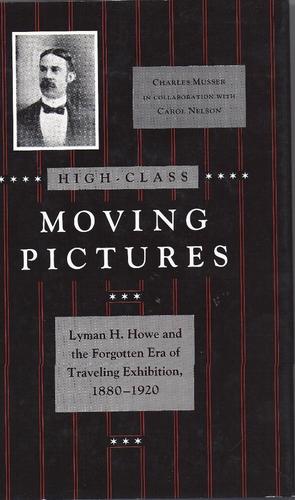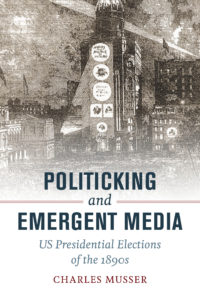 Politicking and Emergent Media: US Presidential Elections of the 1890s (University of California Press, 2016). The 1890s is a decade I can’t seem to escape. Many see it as a pivot point in the history of the United States––and perhaps the world. It is also the first decade of modern motion pictures. In returning to the “long 1890s,” I chose to approach it within a new and different media studies framework. My strategy was to examine four successive presidential campaigns between 1888 and 1900, seeing how Republicans and Democrats mobilized an array of media forms in their efforts to gain victory. The focus then is on the new media of this period–the stereopticon, the cinema, the phonograph and the telephone. I was honored to have the book blurbed by three outstanding colleagues:
Politicking and Emergent Media: US Presidential Elections of the 1890s (University of California Press, 2016). The 1890s is a decade I can’t seem to escape. Many see it as a pivot point in the history of the United States––and perhaps the world. It is also the first decade of modern motion pictures. In returning to the “long 1890s,” I chose to approach it within a new and different media studies framework. My strategy was to examine four successive presidential campaigns between 1888 and 1900, seeing how Republicans and Democrats mobilized an array of media forms in their efforts to gain victory. The focus then is on the new media of this period–the stereopticon, the cinema, the phonograph and the telephone. I was honored to have the book blurbed by three outstanding colleagues:
“Charles Musser shows how screens first entered American politics. Whether they are true politics junkies or frothing critics of America’s quadrennial horse race, readers will be tickled by the resemblances between presidential campaigns then and now. This is media history of the finest kind, rendered by one of our most accomplished scholars of early cinema.”—Lisa Gitelman, author of Paper Knowledge
“In this witty, often amusing, and deeply erudite book, Charles Musser succeeds in denaturalizing breathless contemporary discourse about the newness of emergent technology. It turns out that technology has been newly emerging over the past three centuries, and the performance of politics has long been deeply transformed as a result.”—Jeffrey Alexander, author of The Performance of Politics
“Politicking and Emergent Media is an extraordinary work of historical scholarship, political analysis, and media archaeology. Informed, but not inhibited, by the impact of the Internet and social media on shaping contemporary presidential campaign narratives, Musser not only discovers in the campaigns of the 1890s the active presence of an unexpectedly diverse mediascape comprising illustrated lecture, phonograph, cinema, telegraph, and telephone, but finds already fully in place the disruptive, dispersive, and realigning force of media technologies so typical of American democracy.”—Thomas Elsaesser, author of Film History as Media Archaeology
One of my favorite reviews has appeared in Artforum, by Geoffrey Winthrop-Young: Artforum Review
Consider this book as the dialectic counterpart to:
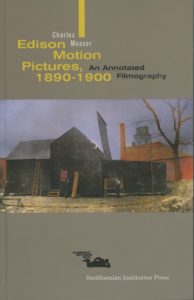 Edison Motion Pictures, 1890-1900: An Annotated Filmography (Giornate del Cinema Muto/Smithonian Institution Press, 1997). Filmographies, Paolo Cherchi Usai has argued, provide the foundations for film history. Agreed. This one was a sheaf of papers as I worked on my early cinema trilogy of books (see below). At a certain point I realized that to make readable books, I would have to leave a lot out. Moreover, in the end, the filmography was an even deeper and also a different kind of project. It would be the foundation for other projects–by me and hopefully by many others. The book received two runner-up prizes from organizations that had honored The Emergence of Cinema. It was assembled before the era of random word access of massive databases. Today it would look very different, but I think it still stands up.
Edison Motion Pictures, 1890-1900: An Annotated Filmography (Giornate del Cinema Muto/Smithonian Institution Press, 1997). Filmographies, Paolo Cherchi Usai has argued, provide the foundations for film history. Agreed. This one was a sheaf of papers as I worked on my early cinema trilogy of books (see below). At a certain point I realized that to make readable books, I would have to leave a lot out. Moreover, in the end, the filmography was an even deeper and also a different kind of project. It would be the foundation for other projects–by me and hopefully by many others. The book received two runner-up prizes from organizations that had honored The Emergence of Cinema. It was assembled before the era of random word access of massive databases. Today it would look very different, but I think it still stands up.
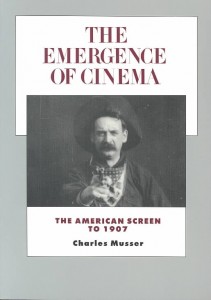 The Emergence of Cinema: The American Screen to 1907 (1990) was the first book in my informal trilogy on American early cinema. Actually it was the last of the three manuscripts to be finished, but Scribners was pushing hard to get it out, so it was the first to be published. In fact, I was indexing it at 2 am on July 19, 1990––the day my daughter Hannah was born. I went home, picked up her mother and we hailed a cab that took us to Roosevelt Hospital, some 12 blocks north. For several years, Hannah thought that the picture on the cover was of me!
The Emergence of Cinema: The American Screen to 1907 (1990) was the first book in my informal trilogy on American early cinema. Actually it was the last of the three manuscripts to be finished, but Scribners was pushing hard to get it out, so it was the first to be published. In fact, I was indexing it at 2 am on July 19, 1990––the day my daughter Hannah was born. I went home, picked up her mother and we hailed a cab that took us to Roosevelt Hospital, some 12 blocks north. For several years, Hannah thought that the picture on the cover was of me!
The book went on to win a number of prizes: the Jay Leyda Prize in Cinema Studies; the Theater Library Association Award for best book on motion pictures, radio and television; and the Katherine Singer Kovacs Prize for best book in Film, TV and Video Studies; Honorable Mention, MLA Prize for Independent Scholars. An Outstanding Academic Book of 1991––Choice; One of the Notable Books of 1991––New York Times.
Stephen Bottomore had kind words for the book in his review in the Historical Journal of Film, Radio and Television: “Musser’s work constitutes a revolution in the study of early American cinema.” It also got a nice review in the New York Times Sunday Book Review from Jeanine Basinger (September 1, 1991).
The book is still in print, available from University of California Press (1-800-777-4726) or Amazon.
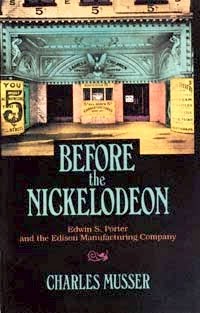 Before the Nickelodeon: Edwin S. Porter and the Edison Manufacturing Company (1991) is a revision of my dissertation of the same name. It was finished in the fall of 1986. Jay Leyda was my dissertation advisor, and this book came out of his on-going course on D.W. Griffith. He showed Griffith’s films in chronological order from The Adventures of Dollie onward. Truth be told, this was the second or third cycle of the class and those in the first cycle were off and running on Griffith-related projects–among them Tom Gunning and his dissertation on Griffith, which became D.W. Griffith and the Origins of American Narrative Film (1991).
Before the Nickelodeon: Edwin S. Porter and the Edison Manufacturing Company (1991) is a revision of my dissertation of the same name. It was finished in the fall of 1986. Jay Leyda was my dissertation advisor, and this book came out of his on-going course on D.W. Griffith. He showed Griffith’s films in chronological order from The Adventures of Dollie onward. Truth be told, this was the second or third cycle of the class and those in the first cycle were off and running on Griffith-related projects–among them Tom Gunning and his dissertation on Griffith, which became D.W. Griffith and the Origins of American Narrative Film (1991).
When I went to NYU in the fall of 1975, I was trying to focus on film theory by taking classes with Annette Michelson. Somewhat ironically it was Ismail Xavier who convinced me to take Leyda’s Griffith class in the fall of 1976. Since it was then generally assumed that Griffith invented film art, my fellow students tended to think that the first close up in a Griffith film was the first close-up in film history. Likewise for the first pan, or the first cut-in. This all seemed a little suspect to me, so Jay arranged to screen a group of Porter/Edison films distributed by the Museum of Modern Art. A quick glance at Life of An American Fireman (1902/03) or The Great Train Robbery (1903) demonstrated that this was not the case. So Ismail and I went down to the Library of Congress and looked at a lot of pre-Griffith films: I took the Edison films and he took the ones made by Biograph. The development of Porter’s rapidly developing mode of representation was easier to encompass than Griffith’s. The films were shorter and there were fewer of them. Nevertheless, it was easy to sketch out the rapid change in motion picture practices in 1900-1903 as editorial control shifted from exhibitor to producer and key aspects of creative control were centralized inside the production company. This made possible a new system of representation involving overlapping action and narrative repetition. Out of this came a paper, “The Early Cinema of Edwin S. Porter,” which won the SCS Student Award for Scholarly Writing (1978). This quickly became a keystone in my idea for a dissertation but that initial idea was quite different from what resulted. I imagined a series of chapters, each of which focused on a different film company. So the 1898-1900 period would focus on Vitagraph, the period from 1903 to 1904 on Biograph and so forth. Angelo Humouda, one of the founders of the Giornate del Cinema Muto, convinced me to write a book devoted solely to Porter and the Edison company–dictating the broad outlines of what became my dissertation and the subsequent book.
In a way, this book had two spin offs. One was my documentary Before the Nickelodeon: The Early Cinema of Edwin S. Porter (1982). The other was The Emergence of Cinema. As I worked on the research and writing of Before the Nickelodeon, I found myself needing to provide a broader industrial context and had gathered a large amount of important material that I was reluctant to waste. The Emergence of Cinema allowed me to narrow the focus of Before the Nickelodeon. Likewise, Before the Nickelodeon enabled me to do something very important with The Emergence of Cinema. I wanted to avoid too much overlap between the two books, so for The Emergence of Cinema I consciously avoided foregrounding Edison, which had been the tendency (understandable in many respects) of previous film histories on American cinema dealing with this period–going back to Terry Ramsaye’s A Million and One Nights (1926).
High-Class Moving Pictures: Lyman H. Howe and the Forgotten Era of Traveling Exhibition, 1880-1920 (in collaboration with Carol Nelson, 1991).

